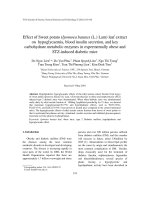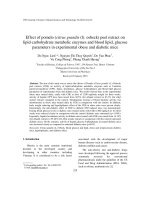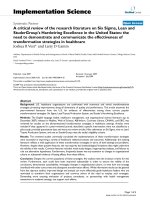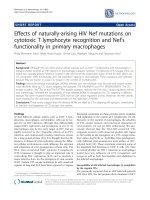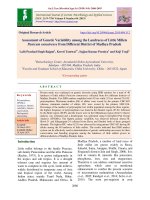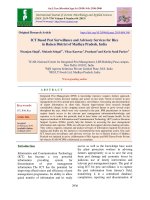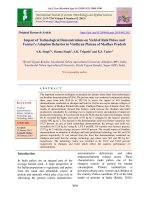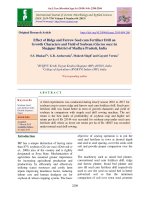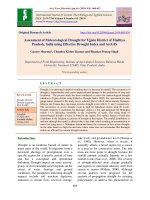Impact of technological demonstrations on yield of Rabi pulses and farmer’s adoption behavior in Vindhyan plateau of Madhya Pradesh
Bạn đang xem bản rút gọn của tài liệu. Xem và tải ngay bản đầy đủ của tài liệu tại đây (235.73 KB, 7 trang )
Int.J.Curr.Microbiol.App.Sci (2019) 8(2): 3094-3100
International Journal of Current Microbiology and Applied Sciences
ISSN: 2319-7706 Volume 8 Number 02 (2019)
Journal homepage:
Original Research Article
/>
Impact of Technological Demonstrations on Yield of Rabi Pulses and
Farmer’s Adoption Behavior in Vindhyan Plateau of Madhya Pradesh
A.K. Singh1*, Mamta Singh2, A.K. Tripathi2 and K.S. Yadav2
1
Krishi Vigyan Kendra, Jawaharlal Nehru Agricultural University Jabalpur (MP), India
2
Jawaharlal Nehru Agricultural University, Krishi Vigyan Kendra, Sagar (MP), India
*Corresponding author
ABSTRACT
Keywords
Frontline
demonstrations;
Impact, Adoption,
Technology gap,
Technology index
Article Info
Accepted:
22 January 2019
Available Online:
10 February 2019
The important extension techniques to persuade the farmers about latest farm technologies
are frontline demonstrations (FLDs). The present study was conducted continuously during
three years from rabi 2015-16 to 2017-18 to assess the impact of 410 frontline
demonstrations conducted on chickpea and lentil in 164 ha area across thirteen villages of
Sagar district of Madhya Pradesh falls under Vindhyan Plateau Agro Climatic Zone. The
results of demonstrations showed that farmers could increase the chickpea and lentil
productivity remarkably by switching over to improved variety and adoption of improved
production technology. It was observed from the FLDs that the improved chickpea variety
JG 63 recorded the higher seed yield (1537 kg ha-1) compared to the farmers' practices
variety (992 kg ha-1). The increase in the demonstration yield over farmer’s practices was
55.27 percent. In case of lentil technology demonstrations, the average seed yield was
recorded to be 1218 kg ha-1 using JL 3, PL 8 and IPL 316 varieties over farmer's practice
(737 kg ha-1) with the average increase of 64.45 percent. The overall impact of frontline
demonstrations on adoption of chickpea and lentil production technology was 461 and 334
percent respectively. It was noticed from the front line demonstrations conducted on
chickpea and lentil that the average technology gap values were 663 and 282 kg ha -1
respectively. The technology index was recorded to be 30.12 and 18.82 percent
respectively in chickpea and lentil which reflect the superior performance of
demonstrations.
Introduction
In India pulses are an integral part of the
average human meal. A large proportion of
the Indian population is vegetarian, and pulses
form the main and affordable source of
protein and minerals which play a key role in
alleviating the protein calorie malnutrition,
micronutrients
deficiencies and other
undernourishment related issues. These
characteristics make pulses one of the
cheapest sources of protein for human
consumption.
Protein
malnutrition
is
prevalent among men, women and children in
the country. Pulses contribute 11% of the total
intake of proteins in India (Reddy, 2010).
3094
Int.J.Curr.Microbiol.App.Sci (2019) 8(2): 3094-3100
Additionally, pulses are a vital source of
livelihood generation for millions of resource.
Based on a study, Singh et al., (2018)
reported that cultivation of pulses requires ten
times less water than producing the same
quantity of animal meat, moreover pulses not
only fix atmospheric nitrogen to the extent of
70-210 kg ha-1 but also lower carbon footprint
because of low carbon emission and higher
carbon sequestration.
Mostly the agriculture is being practiced by
the poor farmers in semi-arid and sub-tropical
regions of the country. Pigeonpea, chickpea,
greengram, blackgram and lentil are the major
pulse crops grown in large areas. Shortfall of
pulses production potential has been
attributed to a number of factors, the major
ones being the increasing population,
inadequate transfer of appropriate technology,
seed
longevity,
poor
seed
quality,
geographical shift, abrupt climatic changes,
complex diseases, pest and socioeconomic
conditions (Ali and Gupta, 2012). India
accounts for 33% of the world area and 22%
of the world production of pulses. About 90%
of the global pigeon pea, 65% of chickpea and
37% of lentil area falls in India,
corresponding to 93%, 68% and 32% of the
global production, respectively (FAO STAT,
2012). In India pulses were grown in 23.5 m
ha area with production of 172 million tonne
in the year 2015-16 and productivity was 728
kg ha-1 (Annual Report of Pulses, 2015-16).
According to agriculture statistics 2014-15,
chickpea, pigeonpea, greengram, blackgram
and lentil was grown in 8.25, 3.55, 3.02, 3.24
and 1.47 million ha with the production of
7.33, 2.78, 1.5, 1.96 and 1.03 million tonne
respectively in the country.
As a result of stagnant pulse production and
continuous increase in population, the per
capita availability of pulses has decreased
considerably. The major constraints in pulse
production are inadequate supply of quality
seeds, low SRR, insufficient use of inputs,
cultivation mostly under rainfed conditions as
more than 87% of the area under pulses is
presently rainfed which reported by Singh et
al., (2018), biotic and abiotic stress,
technology gap, lack of attractive market
price, lack of proper procurement and poor
storage facilities of the farm produce. Drought
stress alone may reduce seed yields by 50% in
the tropics as reported by Saxena et al.,
(2000). Keeping in view the shortfall in
pulses production potential due to various
factors listed above, Krishi Vigyan Kendra,
Sagar
(MP)
conducted
technology
demonstrations on rabi pulses i.e. chickpea
and lentil to enhance the production potentials
and minimize the yield gap in the region.
Materials and Methods
The various technology components to be
demonstrated for chickpea and lentil were
identified based on group discussion. A
cluster of similar farmers was identified based
on their response and feedback received
during the survey and group discussion. The
technology demonstrations were conducted in
Rehli, Jaisinagar, and Rahatgarh blocks of
Sagar district during 2015-16 to 2017-18. A
total of 410 farmers from 13 villages namely
Channua, Parasia (Rehli block), Peepra,
Kishanpura, Manak Chowk, Harbanshpura,
Dhagrania, Maneshiya, Norza, Khajuria
(Rahatgarh block), Hansrai, Masurhai and
Semra Gopalman (Jaisinagar block). The
farmer's practices were considered as control
plot in all demonstrations. All inputs based on
identified technology components viz seed,
seed treatment materials i.e. fungicide
(carboxin + thiram), biofertilizers - phosphate
solubilizing bacteria (PSB) and Rhizobium,
Trichoderma viridae for soil application @
2.5 kg ha-1 and need based insecticides were
provided to the beneficiaries. Soil test based
fertilizer nutrients for NPKS @ 20:60:20:20
kg ha-1 in chickpea and NPKS @ 20:50:20:20
3095
Int.J.Curr.Microbiol.App.Sci (2019) 8(2): 3094-3100
kg ha-1 in lentil was applied. The
demonstration plots were supervised by the
KVK scientists during the crop period. The
data of the demonstrations was collected and
used to assess the impact on yield, adoption
and varietal replacement. The data regarding
adoption was collected from the farmers with
the help of interview schedule. The
demonstrations were undertaken in cluster
approach in the selected villages with the
objective to demonstrate the better production
potentials and benefits of the latest improved
technologies; to enhance the productivity of
pulses in the region and to make farmers self
sufficient in production of quality seed. Data
were subjected to suitable statistical methods
suggested by Samui et al., (2000) which is
given below:
Technology gap = potential yield –
demonstration yield
Extension gap = demonstration yield –
farmer’s practices yield
Technology index (%) = potential yield –
demo yield / potential yield x100
While impact on yield and impact on adoption
was calculated by following formulaImpact on yield (%) = yield of demo plot –
yield of check plot / yield of check plot x 100
Impact on adoption (%) = number of adopters
after demo – number of adopters before
demo/ number of adopters before Demo x 100
(2016-17) and 1918 kg ha-1 (2017-18) with
the pooled yield of 1537 kg ha-1 over farmer's
practice (992 kg ha-1). This showed the
significant increase in yield of chickpea over
control. Yield enhancement in the different
crops in frontline demonstration was reported
by Tiwari et al., (2003), Tomar et al., (2003),
Mishra et al., (2009) and Naberia et al.,
(2015). The trend was similar in case of lentil
technological demonstrations (Table 2),
revealed that the yield of demonstration plots
of lentil was 948 (2015-16), 1401 (2016-17)
and 1304 kg ha-1 (2017-18) with the average
yield of 1218 kg ha-1 in comparison to
farmer's practice (737 kg ha-1). There was
considerable increase in yield of lentil which
recorded to be 39, 87.6 66.78 percent for the
year 2015-16, 2016-17 and 2017-18
respectively with the average increase of
64.45 percent. This show the positive impact
of frontline demonstrations conducted on
lentil in the region. The yield level of check
plot was threatened due to low yielding local /
old variety degenerated seeds, imbalanced
fertilizer application and improper plant
populations.
However,
in
case
of
demonstration plots, the factors led to
enhance the yield of demonstrated crops were,
use of recommended wilt resistant high
yielding variety, balanced dose of fertilizer
nutrients and soil application of Trichoderma
viridae @ 2.5 kg ha-1 for management of soil
born diseases especially wilt and dry root rot.
Results and Discussion
Impact on adoption
Impact of frontline demonstrations on yield
The findings related to impact of FLDs on
yield are presented in table 1 and 2. It is
evident from table 1 that there was
remarkable increase in yield of chickpea
which was noted to be 43.34, 69.28 and 53.19
percent in the year 2015-16, 2016-17 and
2017-18 respectively with the mean value of
55.27 percent. The seed yield of chickpea in
demonstrated plot was 1250 (2015-16), 1444
Impact of FLDs on adoption of chickpea and
lentil production technology by the farmers is
presented in Table 3 and 4 respectively. It was
found that adoption of high yielding wilt
resistant variety of chickpea by the farmers
was less before demonstration which was
increased by 829 percent after conducting
demonstrations due to availability of the
quality seed of the demonstrated variety. Seed
treatment with carboxin+thiram, PSB and
3096
Int.J.Curr.Microbiol.App.Sci (2019) 8(2): 3094-3100
Rhizobium was increased by 1589 percent
due to technology interventions undertaken in
the FLDs. Adopters in seed rate, fertilizer
management and irrigation management were
significantly increased by 1076 percent.
Under lentil production technology the overall
adoption level of various technology
components was increased by 334 percent and
107 adopters were increased after conducting
the technology demonstrations. Similar results
were also reported by Chapke (2012) and
Mahesh et al., (2016) (Table 5).
Table.1 Impact of frontline demonstration on yield of chickpea
Year
2015-16
2016-17
2017-18
Variety
JG 63
JG 63
JG 63
Total
No. of
Farmers
Area (ha)
75
75
75
225
30
30
30
90
Average yield (kg ha-1) Impact (% change
in yield)
FP
RP
872
1250
43.34
853
1444
69.28
1252
1918
53.19
992
1537
55.27
Table.2 Impact of frontline demonstration on yield of lentil
Year
2015-16
2016-17
2017-18
No. of Area (ha) Average yield (kg ha-1) Impact (% change in
Farmers
yield)
FP
RP
Variety
JL 3
PL 8
IPL 316
Total
60
75
50
185
24
30
20
74
682
747
782
737
948
1401
1304
1218
39.0
87.81
66.75
64.45
Table.3 Impact of frontline demonstrations on adoption of chickpea production technology
Technology
Application
of
FYM
Recommended
variety
Seed rate (75 kg)
Seed
treatment
(Fungicide, PSB,
Rhizobium)
Fertilizer
management
Irrigation
management
Overall impact
No. of adopter (225)
Before
After
Demonstration
Demonstration
47
156
Change in No.
of adopter
Impact
(% change)
109
232
21
195
174
829
18
9
179
152
161
143
894
1589
7
161
154
2200
86
201
115
134
31
174
143
461
3097
Int.J.Curr.Microbiol.App.Sci (2019) 8(2): 3094-3100
Table.4 Impact of frontline demonstrations on adoption of lentil production technology
Technology
Application of
FYM
Recommended
variety
Seed rate (40 kg)
Seed treatment
(Fungicide, PSB,
Rhizobium)
Fertilizer
management
Irrigation
management
Overall impact
No. of adopter (185)
Before
After
Demonstration
Demonstration
31
116
Change in No. of
adopter
Impact
(% change)
85
275
17
153
136
802
19
14
142
132
123
118
649
846
11
126
115
1042
101
162
61
60
32
139
107
334
Table.5 Impact of frontline demonstrations on varietal replacement in cluster villages
Crop
Chickpea
Lentil
Previously grown variety
Ujjain 21, JG 315, JG 322
Local unidentified mixed seed
New varieties introduced
JG 63
JL 3, PL 8, IPL 316
Table.6 Seed yield, extension gap, technology gap and technology index of cluster frontline
demonstrations on chickpea and lentil (pooled analysis of three year data from 2015-16 to 201718)
Crop
No. of
FLDs
Potential
yield
(kg ha-1)
Chickpea
Lentil
225
185
2200
1500
Average
Demo
Yield
(kg ha-1)
1537
1218
Impact of FLDs on varietal replacement in
adopted villages
The FLDs include a technology package for
making change in existing farmer’s practices.
It was found that the local / old or
unidentified variety degenerated seeds of
lentil were replaced by JL 3, PL 8 and IPL
316 in FLD clusters. While in chickpea, old
Average Extension Technology Technology
FP yield
gap
gap
index (%)
(kg ha-1) (kg ha-1) (kg ha-1)
992
737
545
481
663
282
30.12
18.82
varieties such as Ujjain 21, JG 315 and JG
322 were replaced by JG 63 a high yielding
wilt resistant variety. Replacement of local/
old or unidentified varieties with new
varieties of maize, paddy and wheat due to
laying out the FLDs was reported by Balai et
al., (2013). The data given in table 6 indicated
that the technology index shows the
feasibility of the evolved technology at
3098
Int.J.Curr.Microbiol.App.Sci (2019) 8(2): 3094-3100
farmer's field. Higher technology index
reflected the insufficient extension services
for transfer of technology. The lower value of
technology index shows the efficacy and
excellent performance of technological
interventions. The average technology index
in chickpea was observed to be 30.12 percent
and in lentil it was 18.82 percent. Similar
results were also reported by Singh et al.,
(2012), Diwivedi et al., (2014) and Tomar et
al., (2003).
On the basis of the above findings it may be
concluded that the frontline demonstrations
enhanced the yield of crops vertically and
ensured rapid spread of technologies
horizontally.
The
technological
demonstrations made positive and significant
impact on enhancement of chickpea seed
yield by 55.27 percent and lentil by 64.45
percent. It was found that the demonstrations
are proven extension interventions to
demonstrate the production potential of
various crops on farmer's field. This may help
to raise the pulses productivity at regional as
well as state and national level.
Acknowledgement
Authors are thankful to Agricultural
Technology Application Research Institute
(Indian Council of Agricultural Research),
Zone-IX, Jabalpur (MP) for providing
necessary budget to conduct the frontline
demonstrations on chickpea and lentil with
the intend to raise the productivity and
livelihood.
References
Ali, M. and Gupta, S. (2012). Carrying
capacity of Indian agriculture: Pulse
crop. Current Science, 102(6): 874-881.
Annual Report (2016). Directorate of Pulses
Development, Ministry of agriculture &
Farmers Welfare (Department of
Agriculture, Cooperation & Farmers
Welfare, GoI), Vindhyachal Bhavan
Bhopal (MP). DPD/Pub/TR/11/201516. pp. 71.
Balai, C.M., Bairwa, R.K., Vema, L.N., Roat,
B.L. and Jalwania, R. (2013). Economic
impact of front line demonstrations on
cereal crop in Tribal belt of Rajasthan.
International Journal of Agricultural
Sciences, 3(7): 566-570.
Chapke, R.R. (2012). Impact of Front Line
Demonstrations on jute (Corchorus
olitorius). Journal of Human Ecology,
38(1): 37-41.
Diwivedi, A.P., Mishra A., Singh, S.K., Singh
S.R.K. and Singh, M. (2014). Yield gap
analysis of chickpea through frontline
demonstration in different agroclimatic
zone of M.P. and Chhatisgarh. Journal
of Food Legume, 27(1): 60-63.
FAO STAT 2012. FAO statistical yearbook
2012. Food and agriculture organization
of the United Nations, Rome 2012.
Ishwar Singh, D.S. Tomar, M.V. Mahajan,
D.S. Nehte, Lakhan Singh and Singh,
H.P. (2018). Impact of Front Line
Demonstration on Chickpea to Meet the
Deficit Pulse Availability in Malwa
Plateau and Central Plateau Region of
India. International Journal of Current
Microbiology and Applied Sciences,
7(02):
2305-2311.
doi:
/>2.279
Mahesh, M., Patil, S. and Chavan, A. (2016).
Impact of FLD intervention on yield,
adoption and horizontal spread of
oilseed crop in Konkan. Indian Journal
of Extension Education, 52(2&3): 7983.
Mishra, D.K., Paliwal, D.K., Tailor, R.S. and
Deshwal, A.K. (2009). Impact of front
line
demonstrations
on
yield
enhancement of potato. Indian Research
Journal of Extension Education, 9(3):
26-29.
3099
Int.J.Curr.Microbiol.App.Sci (2019) 8(2): 3094-3100
Naberia, S., Gautam, U.S. and Gupta, A.K.
(2015). Psychological characteristics
affecting the adoption of Agricultural
Technologies, Indian Journal of
Extension Education, 51(3&4): 130132.
Reddy, A.A. (2010). Regional Disparities in
Food Habits and Nutritional intake in
Andhra Pradesh, India, Regional and
Sectoral Economic Studies, Vol. 10-2.
Samui, S.K., Moitra, S., Roy, D.K., Mondal,
A.K. and Saha, D. (2000). Evaluation of
front line demonstration on groundnut
(Arachis hypogeae L.) in Sunderban.
Journal of Indian Society of Coastal
Agricultural Research, 18(2): 180-183.
Saxena, K.B., D.P. Srivastava and S.B.S.
Tikka (2000). Breaking Yield Barriers
in Pigeon pea through Hybrid Breeding.
In: M Ali, A N Asthana, Y S Rathore, S
N Gurha, S K Chaturvedi and S Gupta
(ed.), Advances in Management of
Biotic and Abiotic Stresses in Pulse
Crops, Indian Institute of Pulses
Research, Kanpur, pp 211-19.
Singh, R.P., Singh, A.N., Diwivedi, A.P.,
Mishra, A. and Singh, M. (2012).
Assessment of yield gap in chickpea
through frontline technology. Journal of
Extension Education, 17(1): 85-89.
Tiwari, R.B., Singh, Parihar (2003). Role of
Front Line Demonstration in transfer of
gram
production
technology.
Maharashtra Journal of Extension
Education, 22(1):19.
Tomar, L.S., Sharma, P.B. and Joshi, K.
(2003). Study on yield gap and adoption
level of potato production technology in
gird region. Maharashtra Journal of
Extension Education, 22(1):15-18.
How to cite this article:
Singh, A.K., Mamta Singh, A.K. Tripathi and Yadav, K.S. 2019. Impact of Technological
Demonstrations on Yield of Rabi Pulses and Farmer’s Adoption Behavior in Vindhyan Plateau
of Madhya Pradesh. Int.J.Curr.Microbiol.App.Sci. 8(02): 3094-3100.
doi: />
3100
